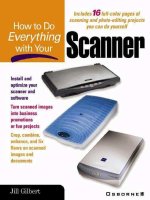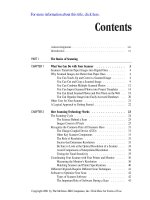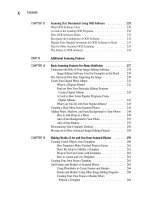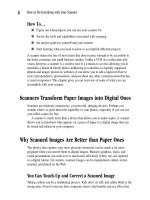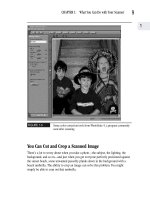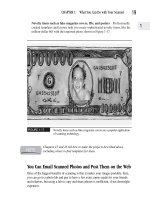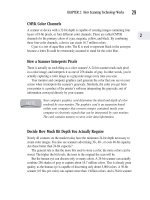How to Do Everything With Your Scanner- P4 potx
Bạn đang xem bản rút gọn của tài liệu. Xem và tải ngay bản đầy đủ của tài liệu tại đây (134.52 KB, 5 trang )
Introduction
Scanners are powerful imaging devices that are now inexpensive enough to be used
for fun and recreation as well as business applications. Once regarded as exotic,
complex design tools, scanners are now simple enough to allow even young children
to experiment and unleash their creativity. Better yet, benevolent market forces have
unleashed inexpensive image-editing software that allows us all to create things in our
homes that were once the exclusive domain of graphic artists. You and your family
can cut, crop, combine, correct, mail, and post your photos electronically. You just
need someone to guide you through the dazzling array of tools you suddenly have at
your disposal—and that, my scanning friend, is the purpose of this book.
Who Should Read this Book?
Everyone who wants to add a visual component to their communication, be it stationery,
greeting cards, or email. This includes small-business owners, hobbyists, and basically
anyone old enough to click a mouse and read the menu options on his or her screen.
Scanning and image editing, with the help of this book, are indeed that simple.
What’s in Each Part of the Book?
The book is divided into four parts to help you complete a course of self-study that
will make you a scanning pro:
Part I explains the basics of how scanning technology works, how to buy a good
scanner, and how to install it and recognize its parts once you get it home.
Part II makes the learning curve for conducting your first scan as brief as possible.
It also gives you a wealth of troubleshooting tips and tricks that will help everyone
from novices to experts. This part concludes by teaching you the basics of editing
scanned images—how to select an image-editing program and how to use the tools
within it.
Part III
expands your scanning horizons toward instantly developed photos (taken
with popular Polaroid cameras), negatives, and slides. It also tells you how to scan a
text document and convert it to a file format, such as Microsoft Word, that you can edit.
Part IV assumes you are ready to turn your scanned photos into works of art, and
to send them to far-flung corners of the world by emailing them and posting them
on the Web. This section even tells you everything you need to know to create
your own website to display your scanned photos.
Copyright 2001 by The McGraw-Hill Companies, Inc. Click Here for Terms of Use.
Please purchase PDF Split-Merge on www.verypdf.com to remove this watermark.
What Features and Benefits Are Included in this Book?
Many helpful editorial elements are presented in this book, including a checklist of
how-to topics at the beginning of each chapter to let you know what’s covered. Skim
through these lists to find out what is relevant and interesting to you. Feel free to skip
anything that isn’t. The chapters of this book are fairly self-contained, and a detailed
index is provided to help you review specific terms and concepts.
You’ll also find step-by-step instructions, figures, and illustrations to guide you
every step of the way. The illustrations themselves are also worth skimming to gauge
and review your familiarity with the topics covered.
Other useful elements include:
■ Tips that point out easier and more efficient ways to do projects and tasks
under discussion
■ Cautions that warn you of common errors and pitfalls
■ Notes that highlight additional relevant concepts
■ How To and Did You Know sidebars that contain useful additional information
about the scanning process and equipment
The following conventions are used in this book:
■ Click means to click an item once using the left mouse button.
■ Double-click means to click an item twice in rapid succession using the left
mouse button.
■ Right-click means to click an item once using the right mouse button.
■ Work area means the area on your computer screen in which an open project
appears for editing.
Let Me Hear from You
If you have any comments about how to make this book better or you want to arrange
to share some of your family photos and scanning projects with me for possible
inclusion in a subsequent edition of this book, by all means drop me a line at my
email address: I practice strict antivirus procedures, so I will
not open attachments, but I will provide you with an address to mail printouts of
interesting scanning projects that you’d like me to consider.
xvi
How to Do Everything with Your Scanner
Please purchase PDF Split-Merge on www.verypdf.com to remove this watermark.
The Basics of
Scanning
Part I
Copyright 2001 by The McGraw-Hill Companies, Inc. Click Here for Terms of Use.
Please purchase PDF Split-Merge on www.verypdf.com to remove this watermark.
Please purchase PDF Split-Merge on www.verypdf.com to remove this watermark.
What You Can Do
with Your Scanner
Chapter 1
Copyright 2001 by The McGraw-Hill Companies, Inc. Click Here for Terms of Use.
Please purchase PDF Split-Merge on www.verypdf.com to remove this watermark.
